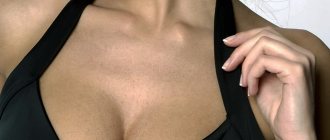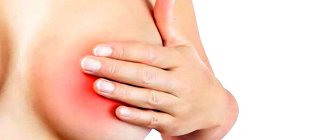Lactostasis is the stagnation of breast milk in the mammary ducts of a woman nursing a baby. A similar condition is observed due to blockage or spasm of the ducts, increased lactation, difficulties with feeding, sudden refusal of the baby to breastfeed, or tight, constricting underwear.
A similar condition manifests itself in the form of compactions, redness and sharp pain in the chest. You can help solve this problem by massaging the breast, pumping or feeding the baby until the symptoms of lactostasis go away.
Indications for the procedure
Massage is an effective technique that helps combat many problems, including lactostasis.
The procedure is recommended to be carried out from the first days of breastfeeding for preventive purposes, or it is recommended to start if a woman develops symptoms such as:
- swelling of the mammary gland;
- soreness;
- seals in the gland;
- redness of the skin on the chest.
Types of massage
There are two types of massage that are applicable to breastfeeding women, and they are selected depending on the goals pursued.
Prophylactic
Light breast massage. It helps to avoid problems with lactation and improves tissue tone. To do this you need:
- place your hand, palm down, on the top of the breast;
- make stroking movements in a circle;
- gradually move towards the nipple;
- wash your breasts with warm water, continuing stroking.
It is very important that the pressure on the chest being developed is not too strong. Preventative massage should be light, pleasant and relaxing
It should be performed immediately before feeding to stimulate milk flow.
Medicinal
It is used when certain difficulties arise during lactation. It facilitates the process of pumping, improves blood flow, while increasing breast tone, and helps get rid of milk that stagnates. How to properly massage the chest for medicinal purposes is worth considering in detail:
- we start with light circular movements of the palm over the surface of each mammary gland; the movement is directed from the collarbone towards the nipple, the movement is carried out in a spiral;
- then from the collarbone to the nipple we carry out direct movements over the entire surface;
- then lightly knead the nipple;
- lean forward and stroke the chest;
- then rinse it with warm water and gently dry it in a circular motion with a terry towel.
This breast massage technique kneads the formed lumps well and helps increase the amount of milk. But remember that the procedure should not cause pain.
Contraindications
Despite the fact that breast massage is considered a useful procedure, there are still a number of contraindications to its implementation:
- the presence of dermatous rashes on the chest and in maximum proximity to the mammary glands;
- exacerbation of chronic diseases;
- high body temperature;
- severe forms of internal organ diseases: heart failure, tuberculosis;
- malignant neoplasms;
- acute infectious processes;
- overwork and stress.
Massage should not be performed on the chest if there are cracks on the nipples. Initially, you should heal the cracks, and then begin the procedure.
How to resolve stagnation with proper feeding
A baby suckling at the breast vigorously moves its lower jaw. He sucks more milk from the part of the breast where his chin is pointed. Feeding a baby should be done in various positions depending on the location of the congestion. It could be:
- Almost under the armpit. The baby is brought to the nipple from under the hand.
- In the center of the mammary gland. Lying on the side, give the baby the upper breast.
- Below the chest. The position “facing mother” is suitable. If the toddler is already large enough, they sit him on his knee facing him, and feed the newborn in a semi-sitting position, resting his back on a pillow.
- At the top of the chest. The baby is placed on his back and leaned over him so that his chin looks up.
If you feed correctly, there is a high probability that the baby will suck at the breast and the congestion will go away on its own.
It is not recommended to stop breastfeeding. The baby helps milk circulate through the glands, which reduces the likelihood of stagnation.
Pumping is useful for treating congestion
Possible complications
Massage for lactostasis in nursing mothers is a simple solution to a complex problem.
If you do not begin to remove congestion in the excretory tracts of the mammary glands in a timely manner, the consequences can be quite serious:
- residual compactions , which may not be immediately noticed, can subsequently cause the development of mastopathy, cysts, neoplasms that are benign or malignant;
- mastitis – develops if an infection occurs and in this case you will have to stop breastfeeding due to taking antibiotics.
If the first signs of lactostasis are observed, you need to urgently begin to fight stagnation and it is better to do this with the help of massage - effectively and harmlessly.
Effects of breast massage during feeding
If massage is done correctly, it will bring nothing but benefits. The effects of breast manipulation can be identified as follows:
- The work of the mammary glands is activated, the muscles relax, and the process of breastfeeding is facilitated. Breast massage is an effective prevention of congestion in the mammary gland.
- Massage stimulates the production of oxytocin, which promotes better milk flow.
- Blood circulation in the breast area increases, which promotes the production of more milk.
- The muscles of the chest are strengthened, this helps prevent the breasts from sagging and losing their shape.
- Massage is an excellent means of preventing stretch marks and helps bring your figure back to normal after pregnancy.
- During the massage, lumps can be detected in the chest if they suddenly form. In this case, the woman will be able to start treatment for lactostasis in a timely manner.
- Doctors necessarily recommend performing breast massage for lactostasis. Correct technique of the procedure helps prevent the development of mastitis.
Preparation
Massage for lactostasis prescribed to a nursing mother should only be carried out in a relaxed state. It is better to perform it while sitting in a comfortable and soft chair or while taking a shower. Your hands should be warm so that they glide better, you can apply massage oil, for example, grape seed or almond, castor or olive may also be suitable.
If you don’t have any oil on hand, and symptoms of lactostasis have already begun to appear, then regular vegetable oil will do. But be sure to make sure that the oil does not get on the nipple and areola.
The procedure should be started after the body and mind are completely relaxed. Only in this state will milk come out of the breast better.
When can you pump?
Cases when it is necessary to express the breast for the sake of the baby:
- Formation of lactation after childbirth. Immediately after the birth of a child, the breasts are filled with a special substance - colostrum. A newborn needs two sips to be satisfied. Do I need to express colostrum? On the third day, primary milk arrives, which is much thinner than colostrum. The chest literally fills up from the large volume, the baby is not yet able to cope with it. Should I express milk or not in this case? If you do not express, a signal will be sent to the brain indicating a decrease in milk production. This cannot be allowed, because the child will soon get stronger and grow quickly. When lactation begins, the breasts are not fully expressed; the procedure must be stopped when the feeling of fullness goes away and the gland itself becomes soft.
- Insufficient lactation. Is it possible to express milk when there is very little milk coming in anyway? The issue is resolved on an individual basis; there is no clear advice in this situation. If pumping increases production, then this must be done in order to maintain lactation.
- Children born prematurely, with an insufficient sucking reflex or born with a pathology. For such babies, breastfeeding is a difficult task. They are usually bottle-fed with expressed breast milk. Mother's milk is the best medicine for them; they must fight for lactation to the last drop.
- Stagnation, the appearance of the first signs of mastitis. The appearance of a lump in the breast is the first sign that there are problems with breastfeeding. You should knead the compacted lobules and find the cause of lactostasis. Perhaps the mother is putting the baby to the breast incorrectly.
- The need to take medications. In situations where the mother's condition requires constant use of medications, she is forced to express and throw away milk. Almost all drugs overcome natural barriers and pass into breast milk.
- Anatomical features of the breast. We are talking about a flat nipple that is difficult for a child to grasp. For such cases, special pads have been developed. A woman should know how to use them. If the situation does not resolve, then the mother is recommended to pump and bottle feed the baby for the first time.
Technique step by step
Massage for lactostasis in nursing mothers should be performed as carefully as possible so as not to cause injury to soft tissues.
During the procedure, you should take into account several useful tips:
- There should be no sudden movements during the procedure. You should not try to break the lump with your hands; it may not dissolve after the first procedure, but strong and aggressive movements will lead to injury.
- The procedure must be carried out with your hands, performing light, stroking and rubbing movements. The hands begin to move from the outside of the chest towards the nipple. Only such movements will help remove lactostasis.
- If during the procedure there is discomfort in the chest, then the massage is combined with pumping and it is advisable to carry it out in the shower with warm water, which promotes the outflow of milk accumulated in the gland.
Preventive massage
It is easier to prevent any congestion in the chest than to remove it later, when the chest is already very inflamed and any even light touch causes unbearable pain. Preventive massage will help prevent the appearance of swelling in the mammary gland, maintain full lactation and improve the nipple without obstruction.
Massage technique for lactostasis in nursing
The procedure helps make the gland soft to the touch, all lumps will disappear and it will be more convenient for the baby to latch onto the nipple.
Preventive measures can be easily carried out at home while showering, or simply apply a warm towel to the gland before the procedure.
The algorithm of actions is as follows:
- begin light circular movements, moving from the edge of the chest and towards the middle, making massage movements with light pressure on the chest with your fingers;
- After performing 2-3 repetitions, massaging the entire chest area, wash it with warm water and repeat the procedure again.
The water should be warm, but not cool. Massage one breast, and then the second, the entire massage time is about 10 minutes. After completing it, you need to express some milk and apply it to the baby’s breast.
Therapeutic breast massage
Massage for lactostasis in nursing mothers, especially the first time it is performed, causes discomfort. The mammary gland is quite dense, hot and swollen. The algorithm of actions cannot be in any way similar to preventive massage; it requires the use of more serious measures. You cannot perform massage movements with dry hands.
Many women, after such a massage, ask their life partner to act as a breast pump - this is not necessary. Thus, you can easily damage the delicate tissue of the nipples and thereby create all the favorable conditions for infection to enter the gland.
Many women do not have any massage skills, especially at the first pain they stop and do not dare to continue further. But any delay ultimately leads to the development of complications that can lead to surgery.
Therefore, if you can’t do a massage yourself, you should seek help from a specialist so that he can help you perform the first procedures and suggest the correct and effective technique.
During the procedure, you should not put too much pressure on the gland, as this will aggravate the discomfort and increase swelling, so all movements are smooth and careful. If the movements provoke discomfort, then the execution technique is broken.
Algorithm of actions:
- You need to hold the breast with your hand, and with the other hand massage the entire surface of the gland with smooth movements, you need to move from the base and heading directly to the nipple, but without touching it;
- after stroking, you need to walk over the entire area of the chest in spiral movements, moving from the base to the center;
- perform circular movements, going clockwise;
- after each breast, you need to take it with both hands, squeeze it slightly, but do not press, and work it in a circle with light movements;
- in those places where compaction is felt, you need to knead it especially carefully without pressure or any sudden movements, but only these areas should be given special attention.
One circle of movements around the entire chest area will not be enough; you need to perform each movement up to 3-4 times. Particular attention should be paid to every cell on the chest, without missing a single area, loosening the pressure in those places where compactions are observed.
If all actions are performed strictly according to the rules, then after performing each movement once, milk begins to be released from the nipple, which must be expressed, freeing the excretory ducts from stagnation.
After the procedure, the breasts must be washed with warm water and blotted with a towel, and then begin feeding. If after the procedure it was not possible to completely get rid of the seals, then the remaining milk should be expressed.
But you shouldn’t do this immediately after feeding the baby. Otherwise, the female body will perceive this as a signal about a small amount of milk and will only increase lactation, which will further aggravate the course of the disease. Expression is carried out after 30-40 minutes. after feeding.
Special exercise for lactostasis
In addition to special massage, you can also remove lumps in the breasts caused by the development of lactostasis with special exercises. With their help, you can normalize the outflow of milk from narrow ducts and activate blood flow in the mammary glands.
The complex includes the following simple and accessible exercises:
- Raise your arms up and bend at the elbows. You should rest your elbows on any suitable support, the main thing is that it is located vertically. Using the chest, you should make spring movements, but you do not need to touch the support.
- Perform the same spring movements as described in the first exercise on only one arm, and then change it. At this time, the second hand should grab the seal and, without sudden and painful movements, pull it down. If the lump slips out of your fingers, you need to lightly squeeze it again.
These exercises should only bring relief, but not discomfort or pain. If the load is selected correctly, then after 2-3 days of regular training all the lumps will dissolve and milk flow will improve.
Hardware massage
If lactostasis is severely advanced, then any touch to the mammary gland provokes severe pain. In this case, a specialist may recommend hardware massage.
Such procedures do not cause pain, promote the rapid and effective resorption of all compactions in the gland, have an anti-edematous effect and relieve spasms.
| Ultrasonic massage | The procedure is carried out using a special device that can produce ultrasound with a power of 0.2-0.4 W/sq. see. The procedure is carried out daily for 5 minutes. After just 3-4 sessions, the woman notices a dramatic change and relief. Ultrasound, acting on the mammary glands, helps expand the ducts, eliminating stagnation, and has a slight warming effect. |
| Magnetotherapy | The procedure is carried out once a day for 7 minutes. using a special device that alleviates the condition, relieves inflammation, stimulates the outflow of blood and lymph, and reduces swelling. |
| Light therapy | The device produces a stream of light with a power of no more than 10 W, which, acting on the seals, helps relieve pain and remove swelling. The procedure takes place within 10 minutes. |
Principle of milk production
In order to safely feed and express breast milk manually, it will be useful for every mother to know how a milk production workshop works.
Where is milk stored?
From the inside, the mammary gland is penetrated by thin threads - milk ducts, in which milk is stored. The baby presses on this area of the breast, squeezing out milk, and stimulates the production of a new portion. For effective pumping, the mother should press on this area of the breast, and not on the nipple.
Breast structure
Oxytocin and prolactin
The process of milk production depends on these two hormones. Prolactin controls the amount of milk and is responsible for its production. As much milk has left the breast, the same amount will come.
Oxytocin is the hormone of love and pleasure. It is produced when a child stimulates the nipple and areola. And is responsible for the release of milk from the milk ducts.
By pressing on the area of the milk sinuses, the baby stimulates the release of oxytocin into the mother’s blood. Milk begins to flow out in strong streams. Mom feels it like a tingling or burning sensation in her chest. Then the pressure weakens, and if the sucking continues, a new flow of milk comes.
It often happens that a nursing mother manages to express no more than a tablespoon. And then worries begin that the baby does not have enough nutrition. The thing is, breast stimulation by a child is a natural process, inherent in nature. But pumping is artificial, and it’s a little more difficult to trigger the oxytocin reflex as needed. But there are some tricks.
In order for pumping to be effective, you need to apply pressure on the breast in the right area and turn on the necessary hormones.
Advantages
Massage for lactostasis in nursing mothers brings benefits:
- helps break up congestion in the excretory ducts;
- accelerates swelling;
- make pumping easier;
- maintain breast shape;
- softens tissues;
- promotes the removal of stagnant milk;
- helps to stretch the passages and improve the circulation of fluid through them;
- stops the development of inflammation;
- helps stabilize the feeding schedule;
- helps a nursing woman calm down and have a positive attitude towards feeding.
Lactostasis or mastitis
If you do not take into account the soreness of the breast, then in general the nurse feels well, the temperature does not rise. Lactostasis can develop in a nursing woman during any period of breastfeeding and when the child is one month old, five months old, or even one year old.
Lactostasis can develop in a nursing woman during any period of breastfeeding and when the child is one month old, five months old, or even one year old.
So, the main cause of this disease is poor emptying of the breast or a certain part of it.
But, it is important not to miss the moment and take all measures to eliminate the blockage of the milk duct, otherwise the situation may worsen
It was widely believed that lactostasis begins after a woman blows in rainy weather or gets her feet wet. Now we know that this cannot be the cause of lactostasis.
The main thing in treatment is no warm compresses.
To determine whether an increase in temperature is related to breast problems, you need to measure the temperature in several places - under both armpits, in the elbow, in the groin. If the armpit temperature is the highest, then we consider it a symptom of uninfected mastitis.
Treatment is the same as for lactostasis (pumping 3 times a day and putting the baby to the breast frequently).
Expressing should not be done manually to prevent the spread of infection to neighboring areas. Warm compresses should not be applied to infected mastitis, as they can provoke the development of an abscess. If all mastitis treatment measures are effective, then pumping is completed on the 10th day.
Disadvantages of the method
Breast massage is a useful procedure, and as experts say, it has no disadvantages. It can cause harm only if excessive force is applied during its execution, which can lead to injury or damage to the skin.
If you violate the technique of performing it, then severe stretch marks may appear. Massage can trigger the active development of tumors, so before using it you should consult with your doctor.
Nursing mothers try to do everything possible to maintain and prolong lactation as long as possible. But no matter how a woman cares for her breasts during lactation, sometimes there is a problem of milk stagnation in the ducts - lactostasis.
To prevent the development of the disease or remove seals that have already appeared, experts recommend using massage. It’s not difficult to do it at home yourself, the main thing is to strictly follow the technique and recommendations of doctors. Just 3-4 procedures and the stagnation will go away, the milk will come in better, and the baby will be full.
A few words about lactostasis
Both in the initial period of lactation and at a time when the process of breastfeeding has already been established, a woman may feel pain in the mammary glands and their engorgement. These symptoms may be accompanied by visible redness of the skin of the chest in some places and an increase in body temperature. In this case, they talk about lactostasis - stagnation of milk in the ducts of the mammary glands.
Lactostasis is characterized by blockage of the milk ducts. If milk stagnation is not eliminated, it can cause inflammation of the mammary gland - mastitis.
Table: causes of lactostasis and main measures to combat it
| Cause of lactostasis | How to fix |
| Insufficient emptying of the mammary glands | Make sure your baby is properly attached to the breast, when the baby grasps the area around the nipple (not just the nipple) with his mouth and can suck milk from different areas of the breast. If the baby is passive when feeding, it is necessary to express milk manually or with a breast pump |
| Holding the breast when feeding with “scissors”, that is, with two fingers | Do not squeeze the milk ducts with your fingers while feeding; hold your breasts without applying pressure |
| Irregular and insufficient breast emptying | Place your baby on the sore breast more often, not forgetting about the healthy one. Practice free feeding (feeding on demand) |
| Tight bra | Wear supportive but not tight underwear |
| Sleeping on your stomach | Sleep on your back or side, this will prevent pinching of your chest. |
| Incomplete emptying of the breast due to sagging of the lower part | Wear a supportive bra |
| Stress, overwork, lack of sleep | Leave time for naps during the day, create a psychologically favorable atmosphere in the house, delegate some household responsibilities to close relatives |
| Injuries, chest bruises, hypothermia | Protect your chest from injury and hypothermia |
| Narrow ducts of the mammary glands | Put your baby to your breast more often |
| Excessive production of breast milk by the mammary gland - hyperlactation | Avoid unnecessary pumping |
The best way to get rid of lactostasis is to feed your baby according to his demand and in the correct position.
The World Health Organization draws the attention of nursing mothers to four signs of proper breastfeeding
Lactostasis is an indication for regular pumping until the ducts are released.
Why is lactostasis dangerous and how does it occur?
During lactation, a woman’s mammary gland changes its internal physiological structure: milk ducts and tubules begin to dominate over the supporting and adipose tissue. Their volume increases in proportion to the baby's need for milk. If more milk accumulates in the breast than the baby needs during one feeding, this may indicate the following problems:
- errors when putting the baby to the breast;
- increased fat content of milk;
- hypothermia of the chest, etc.
Despite the apparent simplicity of the process, lactation will be painless and effective only if the woman approaches the feeding process competently:
- puts the baby to the breast correctly;
- at the first signs of congestion, she takes measures to eliminate it, including doing breast massage.
Under no circumstances should the problem of lactostasis be underestimated. If you think that temporary stagnation of milk will bring you nothing but unnecessary discomfort, then you are mistaken. Sometimes the baby does not have enough strength to clear the clogged ducts. Repeated and prolonged stagnation of milk can lead to inflammation, spread of infection and mastitis. The consequences of these problems are as follows:
- deterioration of maternal health;
- surgical intervention;
- threat to a woman’s life due to the accumulation of pus in stagnant milk ducts;
- cessation of natural feeding.
To avoid the occurrence of lactostasis, a woman should refrain from the following experiments:
- early cessation or refusal of breastfeeding, as well as temporary breaks during which a woman does not express breast milk. If your doctor has prescribed you a course of medication that is incompatible with breastfeeding, do not forget to express milk;
- errors in natural feeding: missed feedings;
- supplementary feeding with formulas in the first months of life;
- feeding the baby by the hour, not on demand.
In the first month of a baby’s life, a woman’s hormonal levels undergo a restructuring. All natural processes proceed rather chaotically
During this period, it is necessary to pay attention to the mammary glands. Mother and baby are mastering a new, yet unusual lactation process
Video: when to pump and when not to
Don’t think that the problem of lactostasis only affects young, inexperienced mothers. When feeding a second or even third child, a woman is not immune from milk stagnation.
What else you need to know about massage for lactostasis
In order for massage to become truly useful and to avoid various types of complications, you should adhere to the following recommendations:
- Before a massage, contraindications must be excluded, these include acute mastitis, neoplasms of unknown etiology, and cysts.
- Contact the skin only with clean hands.
- There is no need to make any effort when massaging, as you can injure the breasts and provoke the development of mastitis.
- If significant pain occurs during the massage, the process should be stopped.
- If milk stagnation or tissue soreness is detected, there is no need to stop feeding; on the contrary, frequent feeding can help get rid of the problem. This is supported by breastfeeding specialists and famous pediatrician Evgeniy Komarovsky.
Lactostasis is not a disease, but is a sign of milk accumulation, but if it is not dealt with, mastitis may develop within a few days. This is already a serious disease that requires special treatment, including antibiotics.











